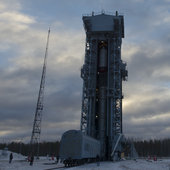 |
|
|
| Nadal fulmina a Federer y alcanza por segunda vez la final de los Maestros |
Nadal fulmina a Federer y alcanza por segunda vez la final de los Maestros
(EFE)
–
hace 8 horas
Londres,
10 nov (EFE).- El español Rafael Nadal se clasificó hoy por segunda vez
en su carrera para la final de la Copa de Maestros en Londres al
imponerse al suizo Roger Federer por 7-5 y 6-3, en una hora y 19
minutos.
El número uno del mundo se medirá mañana lunes contra el
ganador del duelo de esta tarde entre el serbio Novak Djokovic y el
también suizo Stanislas Wawrinka para tratar de conquistar uno de los
pocos títulos que aún falta en su palmarés.
El balear disputará su
segunda final en el torneo que reúne a los ocho mejores del ránking al
término de cada temporada -perdió ante Federer en 2010-, mientras que el
suizo quedó eliminado de un campeonato que ha conquistado en seis
ocasiones, más que ningún otro tenista.
Federer se enfrentaba hoy
en Londres a Nadal y a su propio estado de forma, un día después de un
exigente duelo de dos horas y media ante el argentino Juan Martín del
Potro y al término de una temporada en la que tan solo ha levantado un
torneo menor (Halle), su peor resultado en más de una década.
"La
segunda rotura del segundo set ha sido muy importante. Ganar el primer
parcial era importante aunque con Federer siempre es complicado, porque
como se lo juega todo a cara o cruz, te hace sentir que el partido está
en sus manos", dijo Nadal todavía sobre la pista a Teledeporte.
"Pero
después de haber jugado un partido largo ayer, tenía una ventaja que he
aprovechado", recalcó el jugador español sobre en duelo entre el suizo y
el argentino.
"He hecho un partido correcto", resumió Nadal,
"algunos de los puntos de rotura los he disputado con la decisión
adecuada y quizás Federer ha cometido algún error más de lo normal, y
eso me ha ayudado", dijo Nadal contento de estar en la final de un
torneo en el que nunca ha podido triunfar.
"Históricamente es el
que se me ha dado peor, pero mañana voy a hacer lo posible por ganarlo.
De todas formas, pase lo que pase, este año es de los mejores de mi
carrera", añadió.
A pesar de que su carrera parece haber entrado
en declive, el helvético, el tenista que más torneos del Grand Slam ha
ganado (17), luchaba en esta edición para hacerse con su séptima Copa de
Maestros en uno de sus escenarios fetiche.
En el O2 Arena de la
capital británica, Federer derribó hace dos años con un sonoro 6-3 y 6-0
a Nadal, que nunca hasta hoy había batido al suizo en una pista
cubierta.
El balear, de 27 años, saltaba al tapete azul de Londres
descansado tras el encuentro del viernes ante el checo Tomas Berdych,
motivado para cerrar con honores una temporada brillante en la que ha
vuelto a ser el primer tenista del mundo después de siete meses fuera de
las pistas por su lesión de rodilla.
La ATP entregó esta semana
dos trofeos al español, el que le acredita como número uno en 2013 y el
de Mejor Regreso del Año, pero Nadal no tiene suficiente con eso y está
en Londres, ante todo, para llevarse la Copa de Maestros y redondear un
currículum casi inmejorable.
Sobre el papel, a Federer le
favorecía hoy la pista rápida de Londres, en la que puede encadenar
tiros certeros sin la molestia del viento, mientras que Nadal habría
preferido jugar en un escenario que premiara su genio y su capacidad
para resolver situaciones comprometidas antes que la perfección
estilística del suizo.
El español nunca había gando a Federer bajo
techo, pero hoy salió a la pista convencido de que podía cambiar esa
historia. El mallorquín no cedió un solo punto con su servicio hasta el
sexto juego.
Entonces apareció por primera vez el verdadero
Federer, que puso contra las cuerdas al español con tres bolas de rotura
que Nadal solvento con solvencia y que le sirvieron para asentar su
autoridad sobre la pista.
El suizo, que no había sufrido hasta
entonces al servicio, comenzó a ver cómo el número uno empezaba a estar
inmunizado contra sus ataques y castigaba sus intentos de subir a la
red. Nadal fabricó dos opciones de rotura y aprovechó la primera con un
tiro ganador.
Con todo, Del Potro ya advirtió ayer sábado que una
rotura no es suficiente para sentirse seguro ante un tenista como
Federer, que hoy confirmó esas palabras al echar por tierra en el
siguiente juego la ventaja del español.
El helvético, capaz de
sacarse golpes brillantes que descolocaban a Nadal, sufría al mismo
tiempo demasiados altibajos, que permitieron al español llevarse el
primer set antes del tercer cuarto de hora de partido.
No habían
pasado más de veinte minutos del segundo parcial, cuando el tenista
suizo estrelló en la red una bola que permitió al español adquirir una
ventaja de 3-2.
Federer fallaba demasiados golpes poco
comprometidos como para poner en apuros en el tramo final del partido a
Nadal, que con la confianza de verse a pocos pasos de la final, cerró el
duelo con inusual rapidez, imponiéndose al resto.
©
EFE 2013. Está expresamente prohibida la redistribución y la redifusión
de todo o parte de los contenidos de los servicios de Efe, sin previo y
expreso consentimiento de la Agencia EFE S.A.
Guillermo Gonzalo Sánchez Achutegui






















